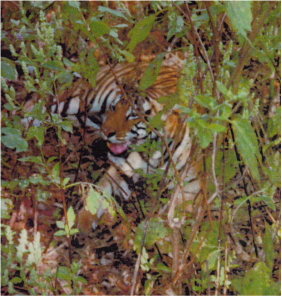
We hadn’t expected to see much as we set out on the elephant. None of our friends had chosen to ride an elephant. We passed clusters of monkeys, grumpy black wild boar, and colorful kingfishers, peacocks, and other birds. Then as the elephant's great feet crunched through the tall grass and bush, we spied the freshly killed body of a large brown swamp deer with an impressive rack of antlers sprawled in the grass between slender crocodile-skin trees.
I started to exclaim, but the mahout sitting in front of me put his finger to his lips. "Shh!" He pointed ahead.
The elephant crunched forward, my legs swinging perilously close to the rough-barked trees. Then we saw her, the female tiger, recuperating from the massive effort of bringing down the deer. Raising her huge head, she glared at us, otherwise motionless, her striped white, black, and orange face a pattern of disdain and distrust.
She let out a low growl and slowly lifted her body until she was standing. Then she shrugged her powerful shoulders, stretched her long body, and ambled away, escaping our scrutiny, to a spot in the grass a few yards away.
Our mahout gave a command to the elephant, directing it toward the tiger, now watching us from her new place. We learned later that, unless provoked, tigers ignore elephants. The mahout maneuvered the elephant so that P. and I each could take photos of the tiger as she warily rested and watched.
Slowly, with stately steps, the elephant crunched through the dry grass and foliage, swinging close to the slender trees, but leaving the resting tiger to recuperate from her battle.
When we’d explored the forest the day before, we'd seen tiger prints in the dirt or heard the warning calls of birds that a tiger was nearby. Now, as Jai said, we'd seen "the grandmother of all tigers."
The nine year-old boy had grown up here in the Kanha National Park game reserve and knew what he said.
This great tiger was in fact the mother of the two female tigers spotted yesterday by the three of us in our jeep and our friends in two other jeeps. She also was the tiger we heard roaring in the distance this morning. Jai's father, the camp manager, had told us that she had three cubs and hunted to feed them. Grandmother or not, she had a family and parental responsibilities.
After we settled in at the camp three days before, one of the local guides and Jai led us on a nature walk through part of the forest, toward a nearby river. Along the way, Jai pointed out the massive, ornately shaped brown mounds with soaring spires that oddly resembled a Gaudi church.
“Termite mounds," Jai explained, in his rather formal Indian English. "Termites build them. They have many rooms inside. The termites drag in leaves that rot and make soil. Then mushrooms grow inside. The termites eat them when they cannot go outside. They are farmers!"
In his piping voice, the handsome boy explained many of the mysteries of this forest in Eastern India. As we drove the narrow dusty tracks looking for game, we glimpsed many termite mounds, some of them clinging to trees, some dug apart by wild boar and other animals seeking a termite dinner.
 RSS Feed
RSS Feed